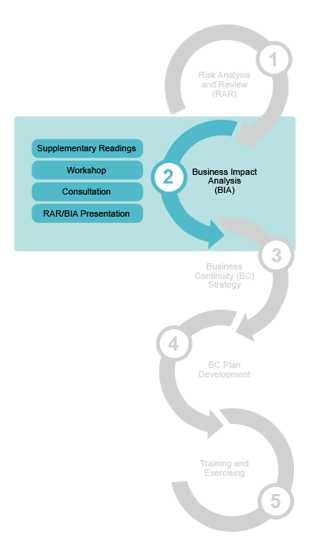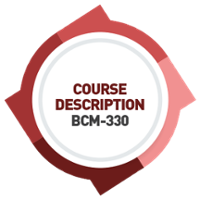Executing the Business Impact Analysis
 At this stage, you are about to attend the second portion of the HRD Corp Claimable BCM workshop usually organised in-house. The course code is WSQ-BCM-310.
At this stage, you are about to attend the second portion of the HRD Corp Claimable BCM workshop usually organised in-house. The course code is WSQ-BCM-310.
This second 1/2 day (or 3-hour) online session or Module 1 Session 2 for Blended Learning "Business Impact Analysis" will be conducted following the completion of the "Risk Analysis and Review" module.
This article is the fourth part of the "HRD Corp Claimable BCM Training with Project Implementation" series. It supports an organisation in its BCM Project Implementation by incorporating training and is supported by value-added consulting services to develop, implement and finalize its BCM program for an organisation.
Business Impact Analysis or BIA is the process of analysing the effects of interruptions on business functions, and the organisation as a whole. And based on the severity of these effects, the Organisation BCM Coordinator would be able to infer the relative recovery priorities of these business functions.

The process of conducting the "Business Impact Analysis" or "BIA" in the HRD Corp Funded Training-led encompassing BCM Project implementation of program update is as follows:

1. Supplementary Readings
- Participants will receive emails containing bite-size information on business impact analysis.
- The purpose of doing so is to introduce them to the key concepts ahead of the coming workshop.
This helps participants optimize their time at the workshop.
What should participants do before the workshop?
Participants (or BU BCM Coordinators) are encouraged to:
- Read through the supplementary material and jot down any questions they may have.
- Complete the e-Learning module "Business Impact Analysis"
- Download the "BIA template from the eCampus LMS Portal
- Complete the BIA templates with the help of the "Guidance Notes" before attending the online workshop
2. Workshop [Online]
A workshop is conducted to guide business unit BCM coordinators to collect data on:
- Critical business functions (CBFs),
- Potential impacts of a prolonged disruption of CBFs
- Time periods within which the CBFs must be recovered, in order to minimize losses
- Key dependencies to perform CBFs
- Resources necessary to perform CBFs

Since this is an online workshop, participants will be put through an E-Learning program "Business Impact Analysis" a week before a ZOOM online session with the instructor himself, giving them the necessary information and context to understand some of the key concepts involved in Business Impact Analysis prior to the actual workshop session itself.
It is important to note that because the workshop is a 1-time group event, it is important that participants lock this event in their calendars.
.png?width=300&name=BL-B-3%20Run2%20ZOOM%20-%20Copy%20(2).png)
No repeat workshop will be conducted for absent participants and there is a possibility that HRD Corp will not approve the course claim if the participant is absent for more than 75% of the module.
What should participants do after the online workshop?
Participants are encouraged to:
- Complete their BIA templates with their BU information based on the learning after the online workshop, if possible, in consultation with the head of the business unit
- Review of the content of submission via email by the Facilitator as an assignment
- Submit the finalized "reviewed" business unit or BU's BIA template submission via upload to BCM Institute's eCampus portal
- Sent all submitted BIA from all the BUs to the Organisation BCM Coordinator for final reporting
3. Consultation [Online]
After the online workshop, participants will have a designated period to complete and submit the templates to their appointed BCM project manager or Organisation BCM Coordinator, who will consolidate the templates and send the first draft of the report to the facilitator.
A complimentary 1-hour consultation session will be arranged for Organisation BCM Coordinator to go through the compiled templates/ report with the consultant.
What Preparation does the Organisation BCM Coordinator need to do prior to the consultation session:
- Get the BIA report template to be presented to the management from the facilitator
- Get all BU BCM Coordinators to submit their completed BIA template after attending the instructor's online session. The BU BCM Coordinators are expected to make edits to their business unit or BU's BIA template after the online workshop session.
- Prior to the consultation session, comments will be sent via email to the designated facilitator.
- Attend the consultation session at the appointed time (on Zoom)
- Process the templates from all BU and write a report for submission to the organisation's management.
- Re-edit the compiled BIA report and prepare to present the revised BIA report for management presentation.
4. RAR & BIA Presentation
.jpeg?width=300&name=Senior%20Management%20Briefing%20(2).jpeg) At this juncture, it is appropriate to update senior management on the progress of the project, as well as to present to them the interim findings of the RAR and BIA. Once the findings are endorsed, the reports are finalized and submitted.
At this juncture, it is appropriate to update senior management on the progress of the project, as well as to present to them the interim findings of the RAR and BIA. Once the findings are endorsed, the reports are finalized and submitted.
What senior management should do:
- Review the key risks for the organization (RAR)
- Review the list of critical business functions and their recovery time objectives (BIA)
- Endorse the findings.
Henceforth, during the next two phases, the business continuity strategy (BCS) and plan development (PD) phases that are developed will be based on these endorsed findings.
We will enter into the Business Continuity Strategy phase of the project only after management's endorsement of the RAR and BIA findings.
5. Public HRD Corp Funded Course
 One of the challenges to maintaining the competency of this program is the training of newly appointed business unit BCM coordinators when they are replacing the incumbent. The newly appointed officer can undergo the same training and he is allowed to bring his/her current templates to the public course offered by BCM Institute. Just make the advanced arrangement with the program administration officer.
One of the challenges to maintaining the competency of this program is the training of newly appointed business unit BCM coordinators when they are replacing the incumbent. The newly appointed officer can undergo the same training and he is allowed to bring his/her current templates to the public course offered by BCM Institute. Just make the advanced arrangement with the program administration officer.
If you are attending a public HRD Corp Funded course, this course is similar to the previous session for the BCM-310 (Course code) and it is titled "Assessing Risk and Business Impact Requirements"
5. Next Step
 Once this session is completed, you are now ready to attend the 2nd one-day HRD Corp Funded course titled "Developing Business Continuity Strategies and Plans." and the course code is BCM-320. Read more about what is the expectation for the next 1/2-day workshop, which is "Evaluating the Business Continuity Strategy".
Once this session is completed, you are now ready to attend the 2nd one-day HRD Corp Funded course titled "Developing Business Continuity Strategies and Plans." and the course code is BCM-320. Read more about what is the expectation for the next 1/2-day workshop, which is "Evaluating the Business Continuity Strategy".
Training-led BCM Implementation Roadmap



















